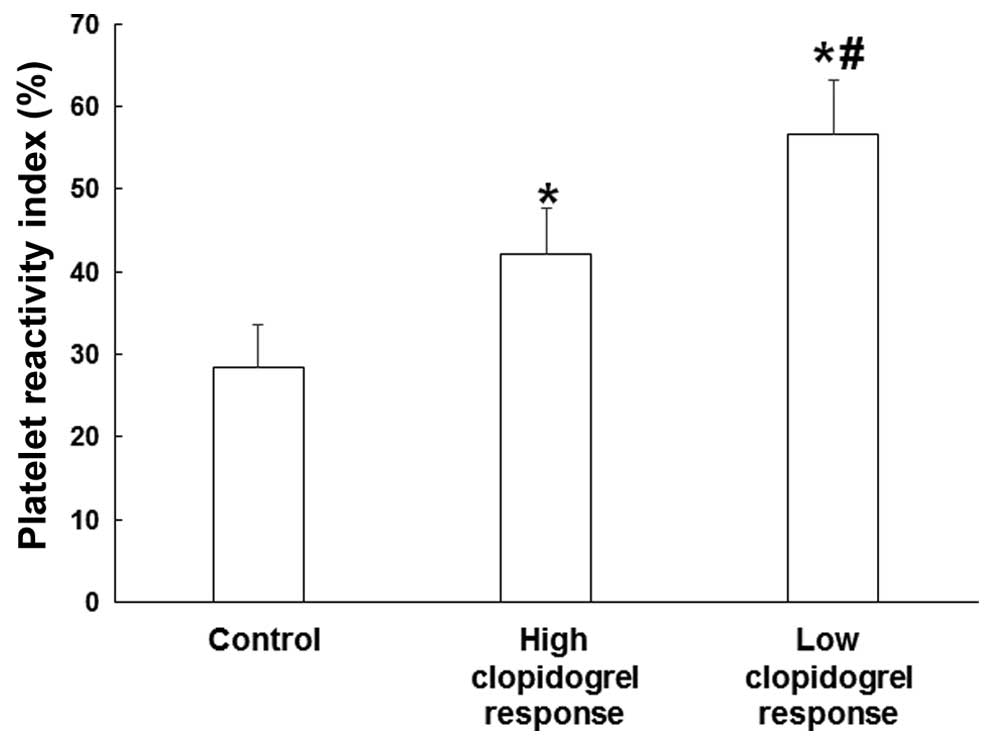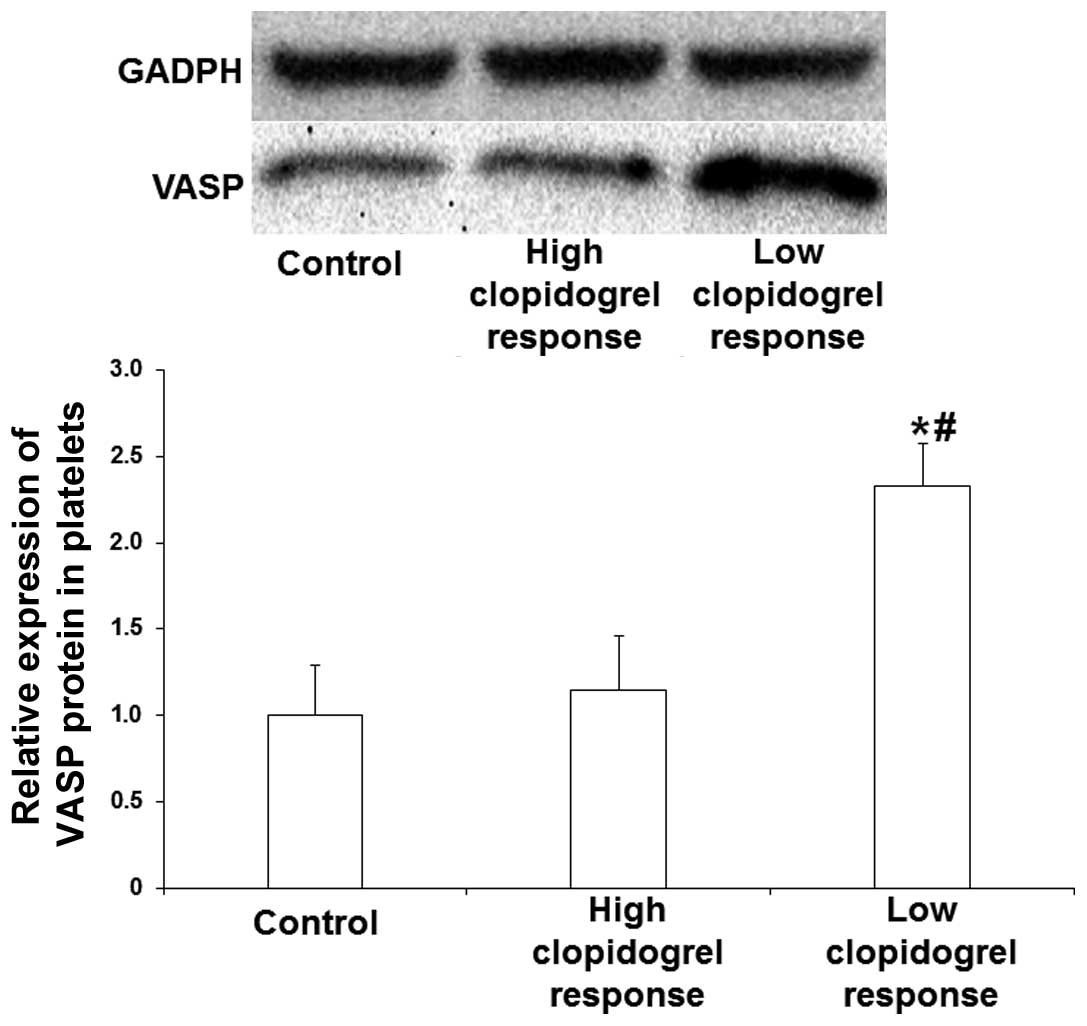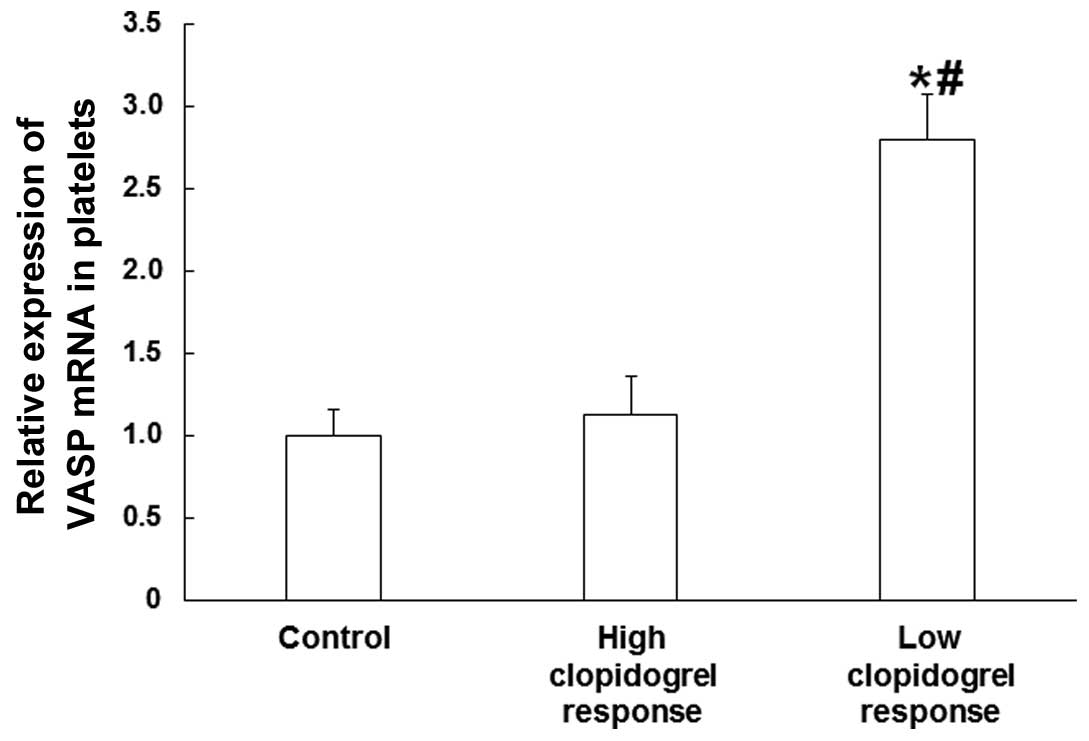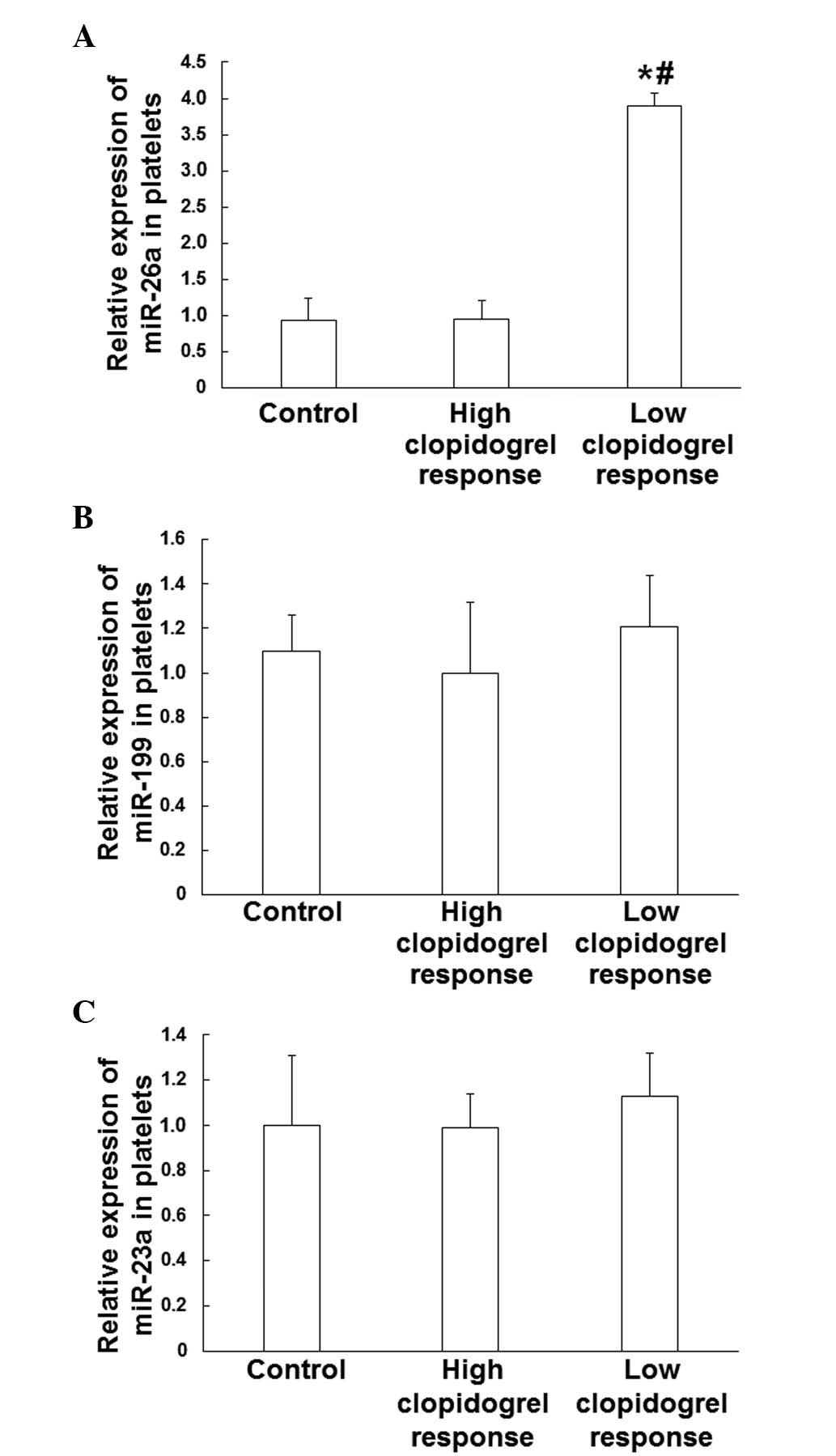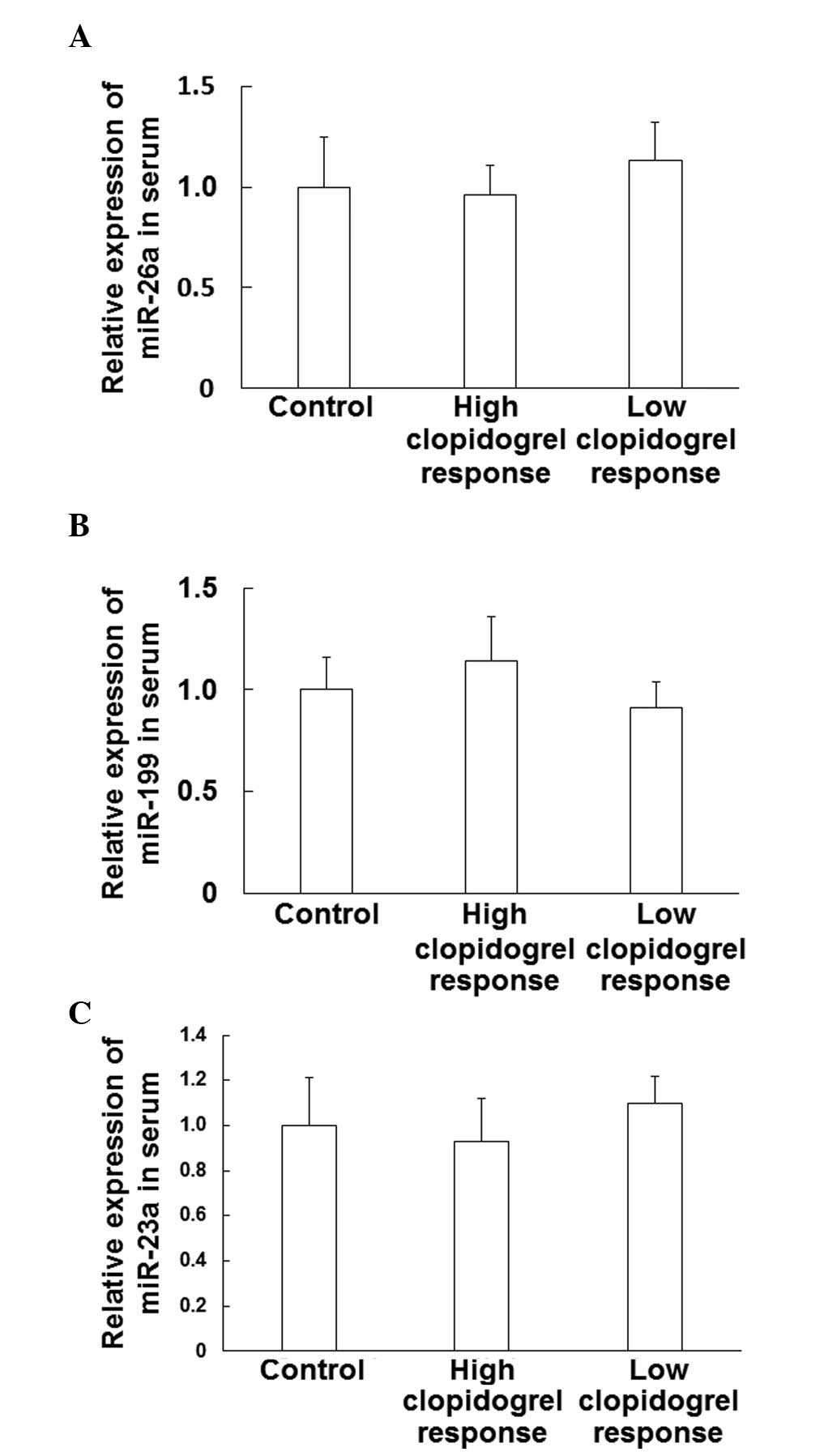Introduction
Clopidogrel is an antiplatelet drug which is the
primary therapeutic agent used to treat patients with coronary
atherosclerotic heart disease who have undergone percutaneous
coronary intervention (PCI) or those with acute coronary syndrome
(1,2). As clopidogrel effectively reduces the
incidence of stent thrombosis and significantly improves the
prognosis of patients with coronary heart disease (CHD), it is one
of the most important drugs for antiplatelet therapy following PCI
(3). Previous studies have
demonstrated that the effects of antiplatelet drugs are dependent
on individual patients. Some patients, predominantly those who have
received coronary stenting due to adverse cardiovascular events,
experience recurring adverse cardiovascular events, despite taking
adequate antiplatelet drugs such as long term clopidogrel (4,5). It has
been suggested that this is due to various factors, including
clopidogrel resistance, which is attracting increasing concern
(6). Clopidogrel resistance is
associated with various factors, including individual differences
between patients, interactions between drugs, polymorphisms in
platelet genes, basic platelet reactivity and platelet sizes
(7–9). However, the molecular mechanism
underlying clopidogrel resistance remains unknown.
Clopidogrel is a type of adenosine diphosphate (ADP)
receptor antagonist that belongs to the thienopyridine class of
drugs. Following transformation by cytochrome P450, the active
metabolites of clopidogrel irreversibly bind to the
P2Y12 ADP receptor on the surface of platelets and block
the inhibition of cyclic adenosine monophosphate (cAMP) by
inhibiting the binding sites of ADP, which promotes cAMP-dependent
phosphorylation of proteins. Inhibition of the binding between
fibrinogen and platelet glycoprotein GPIIb/IIIa receptor, and the
subsequent deactivation of glycoprotein GPIIb/IIIa complexes
inhibits the aggregation of platelets (10).
Vasodilator-stimulated phosphoprotein (VASP) is a
type of intracellular actin regulatory protein, which is a reaction
substrate for cAMP and cGMP-dependent protein kinase. Following
stimulation, the P2Y12 gene is capable of promoting the
dephosphorylation of VASP. Clopidogrel suppresses the P2Y12
receptor, and inhibits the dephosphorylation of VASP. VASP
phosphorylation levels can be determined using flow cytometry to
determine the treatment efficacy of clopidogrel in patients
(11,12).
Previous studies have demonstrated that platelets
exhibit high levels of microRNA (miRNA) expression (13,14),
which has an important role in the pathology of diseases associated
with platelets (15,16). However, few studies have investigated
the effect of miRNA on clopidogrel resistance. Landry et al
(17) have previously demonstrated
that miR-223 regulates the expression of P2Y12 receptor; whereas
Kondkar et al (18)
demonstrated that miR-96 has an important roles in the expression
of vesicle-associated microtubule protein 8. Girardot et al
(19) indicated that miR-28 directly
regulates the thrombopoietin receptor gene. Currently, detection of
VASP phosphorylation levels by flow cytometry is widely used for
the investigation and clinical application of clopidogrel
resistance (20). The present study
investigated whether miRNAs in platelets are associated with
clopidogrel resistance in patients with coronary heart disease
following PCI. The combined miRNA and VASP platelet reactivity
index tests performed in the present study may help with the early
diagnosis and prediction of clopidogrel resistance.
Materials and methods
Patients
Between September 2013 and August 2014, 43 patients
with CHD underwent PCI surgery at Hebei General Hospital
(Shijiazhuang, China). In the same time period, 20 healthy
volunteers without any history of cardiovascular disease were
enrolled in the present study as the control group. The following
information was recorded for patients and healthy subjects: i)
General clinical data, including gender, age, height, weight, blood
pressure, platelet count, fasting plasma glucose level, liver
function, kidney function, blood lipid level and plasma fibrinogen
content; ii) CHD risk factors, including smoking, drinking,
hypertension history and diabetes history; iii) anamnesis,
including chronic hepatitis, chronic gastritis and
thrombocytopenia; and iv) coronarography and PCI results.
Inclusion criteria for the patients with PCI were as
follows: i) Aged between 45 and 80 years; ii) confirmed diagnosis
of coronary atherosclerotic heart disease and planned stent
implantation (≥70% target lesion stenosis, as indicated by
coronarography). Exclusion criteria for patients with PCI were as
follows: i) No significant stenosis or percutaneous coronary stent
implantation contraindications; ii) severe heart failure, which was
defined as left ventricular ejection fraction, ≤30%; iii) severe
liver-kidney dysfunction, which was defined as glutamic pyruvic
transaminase or glutamic oxaloacetic transaminase, ≥80 µ/l and
glomerular filtration rate, ≤125 ml/min; iv) recent history of
bleeding or heparin-induced thrombocytopenia; v) cerebrovascular
disorder within 3 months; vi) major surgery within 1 month; vii)
intake of clopidogrel 1 week prior to hospitalization; viii) life
expectancy <12 months; and ix) allergy to aspirin, clopidogrel,
heparin, stainless steel or contrast medium. All procedures were
approved by the Ethics Committee of Hebei General Hospital. Written
informed consent was obtained from all patients or their
families.
Platelet purification
Peripheral blood samples were supplemented with
citrate dextrose, containing 85 mM trisodium citrate, 78 mM citric
acid and 111 mM glucose, and centrifuged at 80 × g for 10 min at
22°C to obtain the plasma. Following mixing with 2 mM
ethylenediaminetetraacetic acid, the platelet-rich plasma was
centrifuged at 1,000 × g for 10 min at 22°C to deposit the
platelets. Subsequently, 3 ml beads buffer, containing 0.8% NaCl,
0.02% KCl, 0.144% Na2HPO4, 0.024%
KH2PO4, 0.5% bovine serum albumin and 2 mM
ethylenediaminetetraacetic acid, was added to resuspend the
platelets prior to the addition of 40 µl human CD45 MicroBeads
reagent (Miltenyi Biotec GmbH, Bergisch Gladbach, Germany).
Following incubation at room temperature for 45 min with gentle
mixing, a MACS® bead separation system (Miltenyi Biotec
GmbH) was used to collect leukocyte-depleted platelets with purity
>99.99%.
Bioinformatics
For bioinformatics analysis, miRWalk (http://zmf.umm.uni-heidelberg.de/apps/zmf/mirwalk2/),
miRanda (http://www.microrna.org/microrna/home.do) and
Targetscan (http://www.targetscan.org/) databases were used to
analyze the 3′-UTR region of VASP mRNA. The results of the three
databases were collectively used to predict the roles of miR-26a,
miR-199 and miR-23a in the regulation of VASP expression (21).
Reverse transcription-quantitative
polymerase chain reaction (RT-qPCR)
miRNA expression was detected using SYBR Green
(Takara Biotechnology Co., Ltd., Dalian, China) RT-qPCR, with U6
gene as an internal reference for relative quantification. cDNA was
synthesized from 1 µg total RNA using an M-MLV Reverse
Transcription System (Takara Biotechnology Co., Ltd.), according to
the manufacturer's protocol. PCR was performed using a total
reaction volume of 25 µl, composed of 12.5 µl SYBR Premix Ex
Taq (Takara Biotechnology Co., Ltd.), 1 µl PCR forward primer,
1 µl Uni-miR qPCR primer, 2 µl template, and 8.5 µl double
distilled H2O. Primer sequences were as follows:
miR-26a, 5′-CGCGCTTCAAGTAATCCAGG-3′; miR-23a,
5′-ATCACATTGCCAGGGATTTCC-3′; miR-199a,
5′-CCCAGTGTTCAGACTACCTGTTC-3′; and U6, 5′-ACGCAAATTCGTGAAGCGTT-3′.
PCR amplification conditions were as follows: Initial denaturation
at 95°C for 30 sec, followed by 40 cycles of denaturation at 95°C
for 5 sec, and annealing at 60°C for 20 sec (Veriti Dx Thermal
Cycler; Thermo Fisher Scientific, Inc., Waltham, MA, USA). The
2−ΔΔCq method was used to calculate miRNA relative
expression levels (22). Each sample
was measured in triplicate.
mRNA was extracted using TRIzol reagent (Invitrogen;
Thermo Fisher Scientific, Inc.), according to the manufacturer's
protocol. SYBR Green (Takara Biotechnology Co., Ltd.) RT-qPCR was
employed to determine the mRNA expression levels of VASP in
platelets, using glyceraldehyde-3-phosphate dehydrogenase (GAPDH)
as internal reference for quantification analysis. VASP mRNA
reaction system was composed of 10 µl SYBR Premix Ex Taq
mix, 0.5 µl upstream primer (5-′CAACTCAGGAGGAGCCAGAGG-3′), 0.5 µl
downstream primer (5-′TCACCCTCTGTAGGTCCGAG-3′), 1 µl cDNA and 8 µl
double distilled H2O. PCR amplification conditions were
as follows: Initial denaturation at 95°C for 10 min, followed by 40
cycles of denaturation at 95°C for 1 min, annealing at 60°C for 40
sec and elongation at 72°C for 30 sec, and final extension at 72°C
for 1 min. The 2−ΔΔCq method was used to calculate the
relative expression of VASP mRNA (22). Each sample was tested in
triplicate.
Western blotting
Platelets, which were purified from 5 ml whole
blood, were supplemented with 600 µl precooled
radioimmunoprecipitation assay lysis buffer, containing 50 mM
Tris-base, 1 mM EDTA, 150 mM NaCl, 0.1% SDS, 1% Triton X-100 and 1%
sodium deoxycholate (Beyotime Institute of Biotechnology, Shanghai,
China). Following lysis for 50 min on ice, the mixture was
centrifuged at 12,000 × g for 5 min at 4°C. The supernatant was
collected in order to determine protein concentration using a
bicinchoninic acid protein concentration determination kit
(RTP7102; Real-Times Biotechnology Co., Ltd., Beijing, China).
Protein samples (50 µg) were subsequently mixed with equal volumes
of 2X sodium dodecyl sulfate loading buffer prior to denaturation
in a boiling water bath for 5 min. Protein samples (10 µl) were
separated by sodium dodecyl sulfate-polyacrylamide gel
electrophoresis at 100 V. Resolved proteins were transferred to
polyvinylidene difluoride membranes on ice at 300 mA for 1.5 h, and
were subsequently blocked with 50 g/l skimmed milk at room
temperature for 1 h. Subsequently, the membranes were incubated
with polyclonal rabbit anti-goat VASP (1:5,000; cat. no. ab209093)
and polyclonal rabbit anti-goat GAPDH primary antibodies (1:2,000;
cat. no. ab37168) (Abcam, Cambridge, MA, USA) at 4°C overnight.
Following washing three times with phosphate-buffered saline with
Tween 20 (PBST) for 15 min, the membranes were incubated with
horseradish peroxidase-conjugated goat anti-rabbit secondary
antibody (1:1,000; cat. no. ab6721; Abcam) for 1 h at room
temperature. Following washing three times with PBST for 15 min,
the membrane was developed using an enhanced chemiluminescence
detection kit (Sigma-Aldrich, St. Louis, MO, USA). Image Lab
software (verson 4.0; Bio-Rad Laboratories, Inc., Hercules, CA,
USA) was used to acquire and analyze imaging signals. The relative
content of VASP protein was expressed as a ratio of VASP/GAPDH.
Flow cytometry
Flow cytometry was used to measure the
phosphorylation levels of VASP following stimulation with
vasodilators, and to calculate the PRI. At least 6 h prior to
surgery, patients were administered 300 mg clopidogrel, and
clopidogrel was maintained at 75 mg daily following surgery. Seven
days after clopidogrel administration, fasting blood samples (4 ml)
were collected from patients and tested within 48 h according to
the manufacturer's protocol (PLTVASP/P2Y12 kit; Diagnostica Stago
S.A.S., Paris, France). Following count analysis using FACSCalibur
(BD Biosciences, San Jose, CA, USA), the corrected mean
fluorescence intensity (MFI) values (MFIc) of tubes T1 and T2 were
determined. MFIc was calculated from MFI values obtained from MAb
anti-VASP-P (tubes T1 and T2) following subtraction of the negative
controls (tube T3): MFIc (PGE1)=MFIc (T1)=MFI (T1) - MFI (T3); MFIc
(PGE1 + ADP)=MFIc (T2)=MFI (T2) - MFI (T3). PRI was calculated
using the following function: PRI=[MFIc (PGE1) - MFIc (PGE1 +
ADP)]/MFIc (PGE1) × 100. At least one normal sample was tested as a
control for each patient sample. Low response to clopidogrel was
defined as PRI ≥50% on day 7 following administration, whereas high
response was defined as PRI <50% (23).
Statistical analysis
Student's t-tests were performed using SPSS 16.0 for
Windows (SPSS, Inc., Chicago, IL, USA). All data were expressed as
the mean ± standard deviation. P<0.05 was considered to indicate
a statistically significant difference.
Results
Clinical data
Clinical data were collected from 43 patients and 20
healthy subjects (Table I). The data
demonstrated that patients with low clopidogrel response were not
significantly different from those with high clopidogrel response,
according to all clinical data and postoperative cardiovascular
physiological and biochemical indicators. In addition, healthy
subjects were not significantly different from patients with low or
high clopidogrel response in gender, age, smoking, body mass index
or platelet count. However, healthy subjects did not present with
type II diabetes, hyperlipidemia or hypertension. Although still
within the normal range, patients with low or high clopidogrel
response exhibited significantly increased fibrinogen content, as
compared with the healthy subjects (P<0.05). These results
indicated that PCI may not significantly alter CHD risk factors,
such as type II diabetes, hypertension and age, in patients with
CHD.
 | Table I.Clinical characteristics of healthy
subjects and patients with coronary heart disease who underwent
coronary stenting. |
Table I.
Clinical characteristics of healthy
subjects and patients with coronary heart disease who underwent
coronary stenting.
| Characteristic | Control group | Low clopidogrel
response group (n=17) | High clopidogrel
response group (n=26) |
|---|
| Female, n (%) | 7 (35) | 6 (35.29) | 10 (38.46) |
| Age, years | 61.9±5.8 | 62.8±6.9 | 61.3±7.4 |
| Smoker, n (%) | 8 (40) | 7 (41.17) | 9 (34.61) |
| Body mass index,
kg/m2 | 23.83±1.59 | 24.97±2.23 | 23.34±1.77 |
| Type II diabetes, n
(%) | 0 | 7
(41.17)a | 11
(42.31)a |
| Hyperlipidemia, n
(%) | 0 | 7
(41.18)a | 11
(42.31)a |
| Hypertension, n
(%) | 0 | 9
(52.94)a | 14
(53.85)a |
| Fibrinogen content,
g/l | 2.87±0.53 |
3.14±0.49a |
3.06±0.57a |
| Platelet count,
109/l | 200±75 | 223±87 | 219±79 |
| Left ventricular
ejection fraction, % | 61±6.8 |
53.5±11.6a |
54.3±10.8a |
Platelet activity increases in
patients with low or high clopidogrel response
To calculate PRI, flow cytometry was performed to
measure the phosphorylation levels of VASP. Analysis of the results
demonstrated that the number of patients with low clopidogrel
response (PRI ≥50%) was 17 (39.53%); whereas the number of patients
with high clopidogrel response (PRI <50%) was 26 (60.47%). In
addition, the average PRI values of patients with low response or
normal response to clopidogrel were significantly higher, as
compared with the healthy subjects (P<0.05). Notably, the
average PRI of patients with low clopidogrel response was
significantly increased, as compared with the high clopidogrel
response group (P<0.05) (Fig. 1).
These results suggested that platelet activity is increased in
patients with low or high clopidogrel response, as compared with
healthy subjects, on day 7 following clopidogrel treatment.
Platelet VASP protein expression is
inhibited by clopidogrel in patients with high clopidogrel
response, and elevated in patients with low clopidogrel
response
Western blotting was performed to measure VASP
protein expression in platelets. The results demonstrated that
platelet VASP protein expression did not significantly differ
between patients with high clopidogrel response and healthy
subjects, whereas platelet VASP protein expression was
significantly higher in patients with low clopidogrel response, as
compared with healthy subjects and patients with high clopidogrel
response (P<0.05) (Fig. 2). These
results suggested that platelet VASP protein expression may be
inhibited by clopidogrel in patients with high clopidogrel
response, whereas VASP protein expression may be elevated in
patients with low clopidogrel response, who may have high platelet
reactivity.
VASP gene transcription is
significantly increased in patients with low clopidogrel
response
RT-qPCR was used to determine VASP mRNA expression
levels in platelets. The results demonstrated that there was no
significant difference between the platelet VASP mRNA expression
levels of patients with high clopidogrel response and healthy
subjects. However, patients with low clopidogrel response exhibited
significantly increased platelet VASP mRNA expression levels, as
compared with healthy subjects and patients with high clopidogrel
response (P<0.05) (Fig. 3). These
results indicated that VASP gene transcription is significantly
increased in patients with low clopidogrel response, as compared
with healthy subjects and patients with high clopidogrel response,
which exhibit similar low expression levels.
miR-26a expression is associated with
high platelet reactivity
RT-qPCR was performed to determine whether miR-26a,
miR-199 or miR-23a in platelets can target VASP mRNA. The results
demonstrated that relative expression of platelet miR-26a in
patients with low clopidogrel response was significantly increased,
as compared with healthy subjects or patients with high clopidogrel
response (P<0.05; Fig. 4A);
however, this phenomenon was not observed for either miR-199 or
miR-23a (Fig. 4B and C). These
results suggested that the expression of miR-26a in platelets may
be associated with high platelet reactivity, whereas miR-199 and
miR-23a are not.
Serum miR-26a, miR-199 and miR-23a are
not associated with clopidogrel resistance
To investigate whether serum miR-26a, miR-199 or
miR-23a participate in clopidogrel resistance, their respective
expression levels were measured using RT-qPCR. The results
demonstrated that the serum expression levels of miR-26a, miR-199
and miR-23a did not differ among the three groups (Fig. 5A–C). These results indicated that
serum miR-26a, miR-199 and miR-23a are not involved in clopidogrel
resistance.
Discussion
Clopidogrel, which is as a derivative of
thienopyridine with strong antiplatelet activity, has previously
been demonstrated by large-scale clinical trials to reduce the
occurrence of adverse cardiovascular events (1,3).
Although various studies have demonstrated clopidogrel resistance
since its discovery in 2003, the exact mechanism is yet to be
elucidated (24–26). Flow cytometry has been used to detect
platelet activity (27,28), however clopidogrel resistance remains
poorly defined. Furthermore, the association between clopidogrel
resistance and adverse clinical events requires urgent
investigation (29). In the present
study, flow cytometry was used to calculate the PRI, in order to
assess clopidogrel reactivity. As PRI was determined from the
phosphorylation level of phosphoprotein, this method benefits from
relatively increased sensitivity and specificity in defining
clopidogrel resistance, compared with detecting clopidogrel
resistance based on the ADP-induced change of platelet aggregation
rate. VASP phosphorylation specificity reflects ADP receptor
activity, thus avoiding the impact of platelet aggregation induced
by arachidonic acid, thromboxane or fibrinogen (30). In the present study, low clopidogrel
response was defined as PRI ≥50% (23). Among the 43 patients and 20 healthy
subjects investigated, 17 cases exhibited VASP PRI ≥50% (39.53% of
patients following PCI) and 26 had VASP PRI <50% (60.47% of
patients following PCI), with average PRI values of 56.53±2.68% and
42.15±5.08%, respectively.
To date, research on clopidogrel resistance at the
molecular level has predominantly focused on gene polymorphisms
(9,31,32),
rather than associations with miRNA expression in platelets.
Testing VASP phosphorylation is a reliable method for the detection
of clopidogrel resistance, however it lacks early detection and
indicators (20). Therefore, the
present study focused on specific marker miRNAs in platelets that
are associated with the occurrence and development of clopidogrel
resistance. miRNAs are small non-coding RNAs (18–22 nucleotides)
that are capable of regulating gene expression by interfering with
transcription or inhibiting translation, hence miRNAs participate
in the regulation of numerous biological signaling pathways. miRNAs
can stably exist in the blood (plasma, platelets, red blood cells
and nucleated blood cells) or urine, without being degraded by
endogenous RNA polymerase (33).
VASP is abundantly expressed in platelets is abundant and VASP
phosphorylation levels have previously been demonstrated to define
PRI (29). In the present study, the
results of western blotting and RT-qPCR analysis demonstrated that
the protein and mRNA expression levels of VASP in platelets were
significantly increased in patients with low clopidogrel response.
Therefore, we hypothesized that miRNA in platelets may participate
in the regulation of VASP gene transcription. Bioinformatics
analysis of the 3′-UTR region of VASP mRNA predicted that miR-26a,
miR-199 and miR-23a may target VASP mRNA. Subsequent RT-qPCR
analysis of the expression of miR-26a, miR-199 and miR-23a in
platelets and serum demonstrated that only miR-26a expression in
platelets was significantly elevated in patients with low
clopidogrel response. No differences in serum expression of the
three miRNAs were detected among the three groups. These results
suggested that the expression of miR-26a in platelets is associated
with high platelet reactivity, and miR-26a may participate in
platelet reactivity regulation by clopidogrel via the regulation of
VASP expression. However, due to the small sample number and the
complexity and diversity of miRNA regulation mechanisms, the
results of the present study have some limitations. Further
experiments are required to investigate whether a direct regulation
mechanism exists between miR-26a and VASP.
In conclusion, the results of the present study
demonstrated that the expression of miR-26a in platelets has an
important role in clopidogrel resistance. Combined miRNA and VASP
PRI tests may aid the early diagnosis and prediction of clopidogrel
resistance.
Acknowledgements
The present study was supported by the Research
Projects Bureau of Traditional Chinese Medicine of Hebei Province
(grant no. 2013028).
References
|
1
|
CAPRIE Steering Committee: A randomised,
blinded, trial of clopidogrel versus aspirin in patients at risk of
ischaemic events (CAPRIE). CAPRIE Steering Committee. Lancet.
348:1329–1339. 1996. View Article : Google Scholar : PubMed/NCBI
|
|
2
|
Yusuf S, Zhao F, Mehta SR, Chrolavicius S,
Tognoni G and Fox KK: Clopidogrel in Unstable Angina to Prevent
Recurrent Events Trial Investigators: Effects of clopidogrel in
addition to aspirin in patients with acute coronary syndromes
without ST-segment elevation. N Engl J Med. 345:494–502. 2001.
View Article : Google Scholar : PubMed/NCBI
|
|
3
|
Mehta SR, Yusuf S, Peters RJ, Bertrand ME,
Lewis BS, Natarajan MK, Malmberg K, Rupprecht H, Zhao F,
Chrolavicius S, et al: Effects of pretreatment with clopidogrel and
aspirin followed by long-term therapy in patients undergoing
percutaneous coronary intervention: The PCI-CURE study. Lancet.
358:527–533. 2001. View Article : Google Scholar : PubMed/NCBI
|
|
4
|
Kuliczkowski W, Witkowski A, Polonski L,
Watala C, Filipiak K, Budaj A, Golanski J, Sitkiewicz D, Pregowski
J, Gorski J, et al: Interindividual variability in the response to
oral antiplatelet drugs: A position paper of the working group on
antiplatelet drugs resistance appointed by the section of
cardiovascular interventions of the polish cardiac society,
endorsed by the workinggroup on thrombosis of the european society
of cardiology. Eur Heart J. 30:426–435. 2009. View Article : Google Scholar : PubMed/NCBI
|
|
5
|
Angiolillo DJ, Fernandez-Ortiz A, Bernardo
E, Alfonso F, Macaya C, Bass TA and Costa MA: Variability in
individual responsiveness to clopidogrel: Clinical implications,
management, and future perspectives. J Am Coll Cardiol.
49:1505–1516. 2007. View Article : Google Scholar : PubMed/NCBI
|
|
6
|
Wang TH, Bhatt DL and Topol EJ: Aspirin
and clopidogrel resistance: An emerging clinical entity. Eur Heart
J. 27:647–654. 2006. View Article : Google Scholar : PubMed/NCBI
|
|
7
|
Al-Azzam SI, Alzoubi KH, Khabour OF,
Nusair MB, Al-Hadidi H, Awidi A and Saleh A: Factors that
contribute to clopidogrel resistance in cardiovascular disease
patients: Environmental and genetic approach. Int J Clin Pharmacol
Ther. 51:179–186. 2013. View
Article : Google Scholar : PubMed/NCBI
|
|
8
|
Koh YY, Kim HH, Choi DH, Lee YM, Ki YJ,
Kang SH, Park G, Chung JW, Chang KS and Hong SP: Relation between
the change in mean platelet volume and clopidogrel resistance in
patients undergoing percutaneous coronary intervention. Curr Vasc
Pharmacol. 687–693. 2015. View Article : Google Scholar : PubMed/NCBI
|
|
9
|
Bliden KP, Dichiara J, Lawal L, Singla A,
Antonino MJ, Baker BA, Bailey WL, Tantry US and Gurbel PA: The
association of cigarette smoking with enhanced platelet inhibition
by clopidogrel. J Am Coll Cardiol. 52:531–533. 2008. View Article : Google Scholar : PubMed/NCBI
|
|
10
|
Geiger J, Brich J, Hönig-Liedl P,
Eigenthaler M, Schanzenbächer P, Herbert JM and Walter U: Specific
impairment of human platelet P2Y(AC) ADP receptor-mediated
signaling by the antiplatelet drug clopidogrel. Arterioscler Thromb
Vasc Biol. 19:2007–2011. 1999. View Article : Google Scholar : PubMed/NCBI
|
|
11
|
Bonello L, Paganelli F, Arpin-Bornet M,
Auquier P, Sampol J, Dignat-George F, Barragan P and Camoin-Jau L:
Vasodilator-stimulated phosphoprotein phosphorylation analysis
prior to percutaneous coronary intervention for exclusion of
postprocedural major adverse cardiovascular events. J Thromb
Haemost. 5:1630–1636. 2007. View Article : Google Scholar : PubMed/NCBI
|
|
12
|
Cotton JM, Worrall AM, Hobson AR,
Smallwood A, Amoah V, Dunmore S, Nevill AM, Raghuraman RP, Vickers
J and Curzen N: Individualised assessment of response to
clopidogrel in patients presenting with acute coronary syndromes: A
role for short thrombelastography? Cardiovasc Ther. 28:139–146.
2010. View Article : Google Scholar : PubMed/NCBI
|
|
13
|
Nagalla S, Shaw C, Kong X, Kondkar AA,
Edelstein LC, Ma L, Chen J, McKnight GS, López JA, Yang L, et al:
Platelet microRNA-mRNA coexpression profiles correlate with
platelet reactivity. Blood. 117:5189–5197. 2011. View Article : Google Scholar : PubMed/NCBI
|
|
14
|
Plé H, Landry P, Benham A, Coarfa C,
Gunaratne PH and Provost P: The repertoire and features of human
platelet microRNAs. PLoS One. 7:e507462012. View Article : Google Scholar : PubMed/NCBI
|
|
15
|
Duan X, Zhan Q, Song B, Zeng S, Zhou J,
Long Y, Lu J, Li Z, Yuan M, Chen X, et al: Detection of platelet
microRNA expression in patients with diabetes mellitus with or
without ischemic stroke. J Diabetes Complications. 28:705–710.
2014. View Article : Google Scholar : PubMed/NCBI
|
|
16
|
Wang K, Yuan Y, Cho JH, McClarty S, Baxter
D and Galas DJ: Comparing the MicroRNA spectrum between serum and
plasma. PLoS One. 7:e415612012. View Article : Google Scholar : PubMed/NCBI
|
|
17
|
Landry P, Plante I, Ouellet DL, Perron MP,
Rousseau G and Provost P: Existence of a microRNA pathway in
anucleate platelets. Nat Struct Mol Biol. 16:961–966. 2009.
View Article : Google Scholar : PubMed/NCBI
|
|
18
|
Kondkar AA, Bray MS, Leal SM, Nagalla S,
Liu DJ, Jin Y, Dong JF, Ren Q, Whiteheart SW, Shaw C and Bray PF:
VAMP8/endobrevin is overexpressed in hyperreactive human platelets:
Suggested role for platelet microRNA. J Thromb Haemost. 8:369–378.
2010. View Article : Google Scholar : PubMed/NCBI
|
|
19
|
Girardot M, Pecquet C, Boukour S, Knoops
L, Ferrant A, Vainchenker W, Giraudier S and Constantinescu SN:
miR-28 is a thrombopoietin receptor targeting microRNA detected in
a fraction of myeloproliferative neoplasm patient platelets. Blood.
116:437–445. 2010. View Article : Google Scholar : PubMed/NCBI
|
|
20
|
Aleil B, Ravanat C, Cazenave JP, Rochoux
G, Heitz A and Gachet C: Flow cytometric analysis of intraplatelet
VASP phosphorylation for the detection of clopidogrel resistance in
patients with ischemic cardiovascular diseases. J Thromb Haemost.
3:85–92. 2005. View Article : Google Scholar : PubMed/NCBI
|
|
21
|
Dweep H, Gretz N and Sticht C: miRWalk
database for miRNA-target interactions. Methods Mol Biol.
1182:289–305. 2014. View Article : Google Scholar : PubMed/NCBI
|
|
22
|
Livak KJ and Schmittgen TD: Analysis of
relative gene expression data using real-time quantitative PCR and
the 2−ΔΔCt method. Methods. 25:402–408. 2001. View Article : Google Scholar : PubMed/NCBI
|
|
23
|
Cuisset T, Frere C, Quilici J, Gaborit B,
Castelli C, Poyet R, Bali L, Morange PE, Alessi MC and Bonnet JL:
Predictive values of post-treatment adenosine diphosphate-induced
aggregation and vasodilator-stimulated phosphoprotein index for
stent thrombosis after acute coronary syndrome in
clopidogrel-treated patients. Am J Cardiol. 104:1078–1082. 2009.
View Article : Google Scholar : PubMed/NCBI
|
|
24
|
Nguyen TA, Diodati JG and Pharand C:
Resistance to clopidogrel: A review of the evidence. J Am Coll
Cardiol. 45:1157–1164. 2005. View Article : Google Scholar : PubMed/NCBI
|
|
25
|
Spokoyny I, Barazangi N, Jaramillo V, Rose
J, Chen C, Wong C and Tong D: Reduced clopidogrel metabolism in a
multiethnic population: Prevalence and rates of recurrent
cerebrovascular events. J Stroke Cerebrovasc Dis. 23:694–698. 2014.
View Article : Google Scholar : PubMed/NCBI
|
|
26
|
Gurbel PA, Bliden KP, Hiatt B and O'Connor
CM: Clopidogrel for coronary stenting: Response variability, drug
resistance, and the effect of pretreatment platelet reactivity.
Circulation. 107:2908–2913. 2003. View Article : Google Scholar : PubMed/NCBI
|
|
27
|
Jy W, Horstman LL, Park H, Mao WW, Valant
P and Ahn YS: Platelet aggregates as markers of platelet
activation: Characterization of flow cytometric method suitable for
clinical applications. Am J Hematol. 57:33–42. 1988. View Article : Google Scholar
|
|
28
|
Satoh K, Yatomi Y and Ozaki Y: Detection
method for platelet activation markers. Rinsho Byori. 50:773–778.
2002.(In Japanese). PubMed/NCBI
|
|
29
|
Bonello L, Tantry US, Marcucci R, Blindt
R, Angiolillo DJ, Becker R, Bhatt DL, Cattaneo M, Collet JP,
Cuisset T, et al: Consensus and future directions on the definition
of high on-treatment platelet reactivity to adenosine diphosphate.
J Am Coll Cardiol. 56:919–933. 2010. View Article : Google Scholar : PubMed/NCBI
|
|
30
|
Morel O, Viellard C, Faure A, Jesel L,
Ohlmann P, Desprez D, Chauvin M, Roul G, Grunebaum L and Bareiss P:
Platelet responsiveness to clopidogrel in patients with coronary
syndrome. Comparison of platelet aggregation induced by ADP and
flow cytometric analysis of intraplatelet VASP phosphorylation. Ann
Cardiol Angeiol (Paris). 56:21–29. 2007.(In French). View Article : Google Scholar : PubMed/NCBI
|
|
31
|
Kim KA, Park PW, Hong SJ and Park JY: The
effect of CYP2C19 polymorphism on the pharmacokinetics and
pharmacodynamics of clopidogrel: A possible mechanism for
clopidogrel resistance. Clin Pharmacol Ther. 84:236–242. 2008.
View Article : Google Scholar : PubMed/NCBI
|
|
32
|
Notarangelo MF, Bontardelli F and Merlini
PA: Genetic and nongenetic factors influencing the response to
clopidogrel. J Cardiovasc Med (Hagerstown). 14(Suppl 1): S1–S7.
2013. View Article : Google Scholar : PubMed/NCBI
|
|
33
|
Berezikov E, Cuppen E and Plasterk RH:
Approaches to microRNA discovery. Nat Genet. 38(Suppl): S2–S7.
2006. View
Article : Google Scholar : PubMed/NCBI
|















